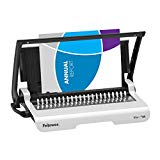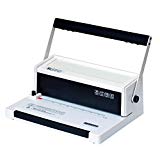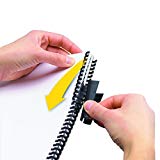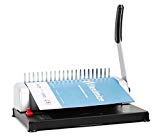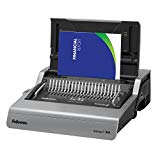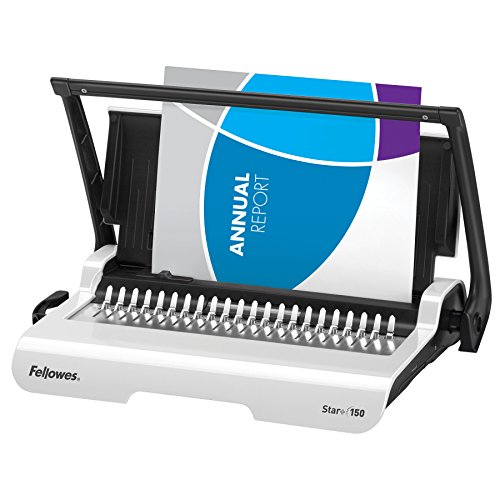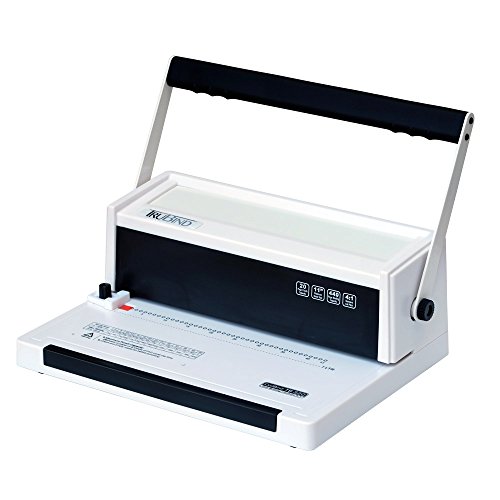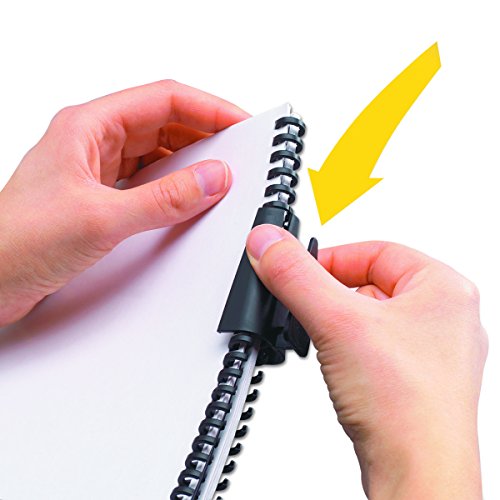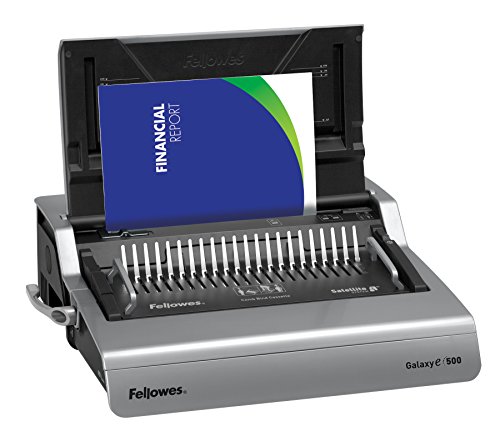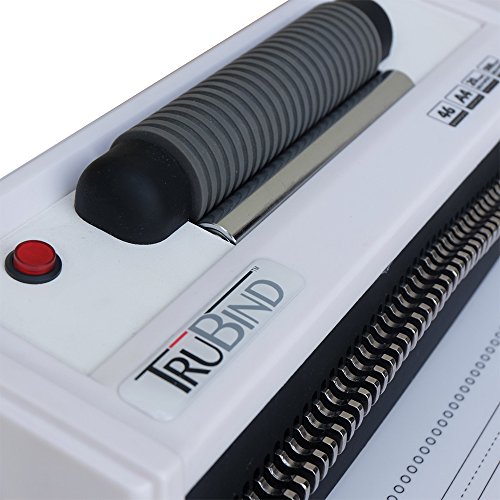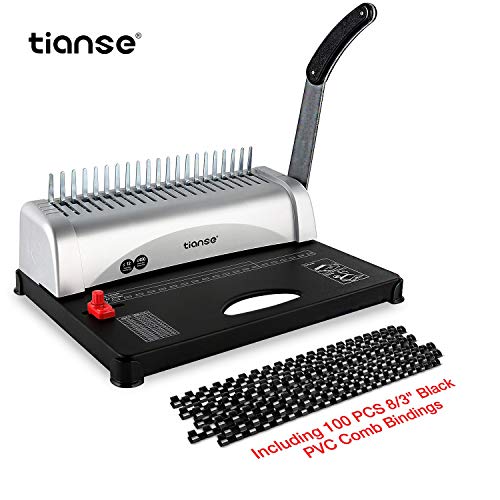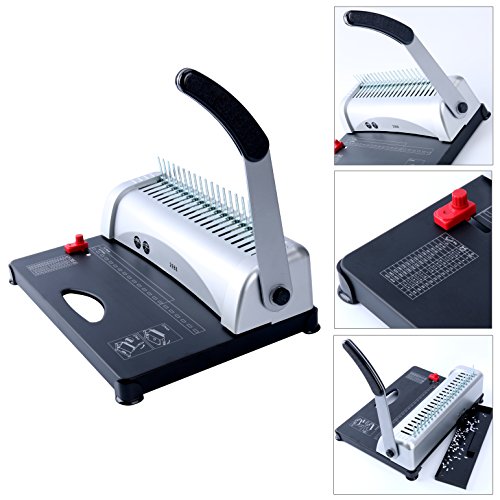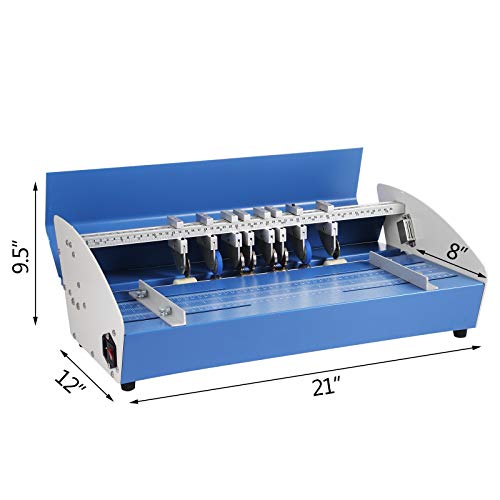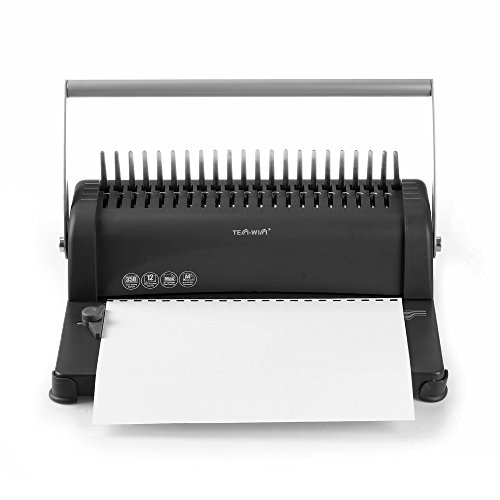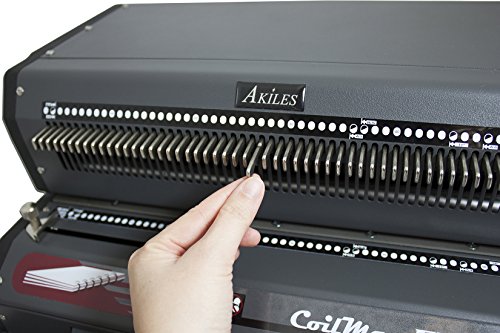Best Binding Machines Review [Top Picks of 2023]
Some might think this type of machines has very limited use, but binding machines are more widely used than you think. They are used for paperwork, in stationery shops, and publication offices.
This demand pushes brands to produce a wide variety of designs and functions. As a result, you often have a grand array of products to choose from.
However, this might beg the question, which is the best binding machine?
Now that’s a difficult question. The answer depends on what you’re looking for, how much those certain criteria matter, and of course, the economical aspect. The end goal is that you don’t feel like you’ve been ripped off after your purchase.
Image | Name | Editor's Rating | Price |
|---|---|---|---|
5 out of 5 | |||
5 out of 5 | |||
4.5 out of 5 | |||
5 out of 5 | |||
4 out of 5 |
Table of Contents
Our Top 11 Best Binding Machines in 2023
Now, you might be thinking, a binding machine is a quite technical device, and its assessment might be a bit difficult. However, you need not worry, we're here to break down all the complex things.
To help you out, we've short-listed eleven finest binding machines for you to choose from.
1. Fellowes Comb Binding Machine
As the name suggests, this model by Fellowes, is a comb paper binding machine. The takeaway from this one is that it is very suitable for domestic use. That’s because this thing is lightweight and easy to operate.
It is a very simple device, and thus ideal for the casual user. One of the merits of it is that this thing is small and doesn’t occupy much space. As a result, it can be easily carried around and used whenever need be. Owing to this feature, you can keep this at your home and office and enjoy functionality coupled with portability.
Continuing the theme of its simplicity, the machine is operatable with ease. Now it is quite understandable if someone has issues with operating a binder machine. All the complicated levers and punches might seem a little daunting. But fret not, the instructions in this are very clear and easy to comprehend.
Despite the simpleness, it does pack in some nifty features. It includes a handy storage tray coupled with a built-in comb sizing system, situated on the right side of the binder for the ease of the user.
A tiny window located at the top side of the binder lets you see the amount of punched paper in the dump bin. This is particularly useful if you're using this a lot and you have to go through several punches so you can take them out easily.
It can take up to about eleven papers in one go and punch them. Which is something that can be viewed as both good and bad. It definitely is not an issue for the casual user, as they hardly have to bind many papers. But it isn't ideal for professional use. So, professionals may have a bad time with this thing.
Highlighted Features
2. TruBind Coil-Binding Machine – TB-S20
Instead of a comb, this instrument by TruBind uses a coil. The coil can be plastic, or metallic. But that’s irrelevant, as the sizing only matters here. Again, this one consists of a simple enough design for you to easily work with.
One of the best features this product boasts is its flexibility. Many binders might stick to a specific size and dimension, but this one allows you to use any paper. So non-conventional sizes and bits are all on the table. This might be especially useful if you’re doing customized work.
When it comes to operations, the manual, as stated by some of our testers, did not really help at all. It compelled many to look up online for the instructions. Hence, that’s a minus point here. Despite so, when you have gathered a decent understanding of how it works, the rest is a breeze.
It presses easily and handles really well. The press bar is constant across the machine, so you can remain assured that it’ll do the job. Opposed to many paper binding machines that have the presser on one side, this one caters to both left-handed and right-handed people.
Up to twenty papers can be pressed at a time. This again is quite enough for the average user, who might bind together assignments only, and may not need more than a few presses. Again, however, if you’re looking to bind a book, this will require some patience.
Another challenge this binder does unfortunately pose is that the coil needs to be bound onto it manually. There is no guide or anything for this one. So, you need to practice a little to twist the coil into the holes made by the machine. This might be a little taxing to some of you, especially those who want a quick bind.
Highlighted Features
3. Swingline GBC Binding System
This binding system is brought to you by GBC which is a reputed brand. The presser is small, sleek and light, portable and durable. Coupled with that, the spine, as in the binding mechanism, is reopenable so that you can add more sheets if you want.
The presser is a tiny, compact, tool that can cut up to six pieces of paper. Laminated paper is not much of an issue either. Again, this is definitely geared towards the infrequent users.
It’s a nifty tool to make booklets, manuals, and similar stuff. Unsurprisingly, this one isn’t suitable for professional use. It is basically something you could carry around and use when you need to bind a few papers together. Hence, a wonderful tool for students.
It provides a good deal of flexibility as well. Despite being smaller than average size, this tool allows punching of papers of variable area. Apart from professional sizes, bigger sizes such as A3 paper, fit right in and can be punched. It is lightweight, and quite durable as well as offering long-lasting performance.
The second item in the set consists of a spine, the binding element of the binding system. Opposed to other systems, this is an editable form of binding since you can snap open the binding either with an editing tool, or just with your bare hands and simply add or subtract pages as you see fit.
This can prove to be a very valuable asset as you don’t have to take the entire binding out.
In regard to durability, the spine is well-made and securely holds your documents together. No assembly is required so you can start as soon as you have signed the receipt for the delivery.
Highlighted Features
4. Kenley Binding Machine
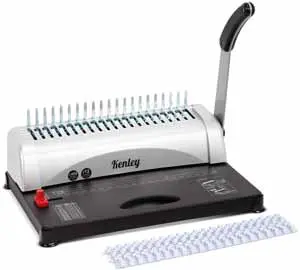
Employing plastic combs as the binding system, the machine developed by Kenley dips its toes into the “professional” realm. It sits on the fence a little and hence is still viable for the casual user.
But if you want to run this for a professional task, it hits the bar and gets the job done. So, it does hold merit in being a “jack of all trades” type machine.
It comes with plastic combs so you can bind them in. Again, this is to be done manually, so it does take some practice and some patience. This does have a guide to help you with the process. After you’re done pressing, just carefully stick it inside.
And don’t worry about the thickness of the paper either. It can easily cut up to twelve sheets of paper all at once. So, simply put, you could bind a whole book together with this within an hour. Plastic sheets can be cut with this as well, although they are usually able to cut through two at a time.
Unlike many binding machines, that may pose the conundrum of how to use it properly without damaging your paper; this machine describes the entire process in detail inside the manual. It also lists the comb sizes for the corresponding number of sheets of paper.
The machine definitely is durable and lasts as well. Despite the fact that it can be used for office work, it is manufactured for medium scale use and gives the best performance there.
However, one flaw that it has is that its punching path is fixed, i.e., it can punch and bind only a few sizes of paper. While it can punch other sizes, it only does so partially so it can be difficult to realign and finish the punch.
Many users may end up ruining the paper altogether, so it is advisable to practice with some scrap before this is attempted.
Highlighted Features
To anyone who is looking for a professional piece, this might be what you are looking for. The binding machine by Fellowes is a high-performance device with great features.
Consequently, it finds its way to areas that use stationery frequently, such as offices since it’s regarded as the best spiral binding machine by a lot of people.
Operations on this are literally done at the push of a button. This is highly desirable in a busy office setting where you cannot really be bothered to go through all the motions of manually tying the binder by yourself.
The press is powerful and is definitely of professional grade. It can make short work of the pages provided, even as far as twenty five sheets of paper in one go. This means it is a factory level instrument, capable of busting out books and extended documents in a very short amount of time.
In an ode to its single button function, it automatically binds all the paper it presses to a neat stack. In fact, it can automatically bind up to half a thousand pages at once. So, if you’re binding a book or an extensive report or thesis, this can punch it all in a couple of sessions and bind them in one go.
Automation on this device goes farther as it can measure and suggest the right comb for you to use to bind it. It also separates the punching and binding spaces. This means that you could conduct binding work in addition to punching operations without interference, thereby achieving greater efficiency.
It is also versatile in the sense that it can press many different types of paper. So, larger or smaller sizes of paper can be used.
Lastly, since this machine is geared for more extended and professional use, it comes as no surprise that it can keep the same performance for a long time. It is made in a way to work with accuracy and precision. Therefore, I’m sure, you won’t regret it if you give this thing a chance.
Highlighted Features
This one is another professional tier, high-performance instrument that you need to know about. The polish and finishing on this thing are remarkable. The controls are easy, and the machine itself is quite versatile and can be used for office as well as other purposes. The machine was built to give high output.
It is designed to churn out a full twenty stacks of paper in every punch and with precise consistency. The device can run for hours without rest and any kind of issues. You can bind a book, heavy research material, or any other voluminous stack of papers with this guy.
When it comes to options, the machine offers customizability to a very good extent. A full set of disengaging pins exists so that you can freely control the positioning and placement of the holes in the punch. This can help you avoid tear and openings in your paper.
Extending that options, you can use any type of paper and get a binding out of it. It supports the punching and binding of non-conventional sheets of paper. So, you can use art paper, portrait paper or legal paper to work and bind the documents together to create your desired book.
You don't have to fret about working your way to bind your work either; the electric binding system facilitates automatic binding of the paper sheets.
There have been some who tried it and found that the motor runs too fast and often disorients everything. However, with practice, it is possible to overcome this problem. In fact, you can take advantage of its speed and get the work done fast.
The controls are easy to use as well. Auto spiraling is easily achieved with a single push of a button. The presser is a continuous bar; this allows the left or right-handed user to press the machine with convenience. It is also durable and long lasting with high working hours. Overall, this guy is ideal for an office setting.
Highlighted Features
Keep in mind that this guy is a light duty, mid-tier machine. So, you must keep your expectation in check. The bottom line is that it’s suitable for light office work and home use. Overall it is a compact, versatile machine with ease of control and all the while providing consistent quality at every step and every punch.
Operating this machine is very easy. You just align the paper along the opening and punch it in. There are no confusing settings or any additional setup of any other kind for you to mess things up. It's just a punch, essentially, and incredibly convenient to operate.
The reason I said that the machine was mid-tier is because of its maximum working capacity. If you wanted a professional high-performance machine, the output capacity would be about twenty or so pages per punch. However, this one only provides about half that.
At ten pages per punch, it is good for mid-tier and small jobs around house and light office work. But have no doubt that, it is not made for extensive use.
Since it is not an electrical binder, it is bound manually instead of being bound automatically with the plastic comb. Yes, it is slow, and you might end up crumpling up a few sheets out of the strain of trying to hook it all up, but once you get the hang of it, you can do it fast. All you need is some practice and some perseverance.
The design is also very compact, and it is overall quite lightweight. If you are looking for a portable and best binding machine that you can move around the house or office, then this one should be your go-to choice.
Resilience and robustness are also some of the merits of this device. While not made for extensive use, this will last long if used moderately. And let me assure you that, its performance won’t deteriorate over time. Thus, you can expect years of service from this device.
Highlighted Features
The binding machine has been manufactured by YaeKoo and is one of the finest you can find on the market. This one is made for medium level jobs and can find its way to homes for some paperwork or regular office stationery tasks.
In accordance with its purpose, the number of sheets of paper it will punch through is around ten or so, maybe a maximum level of twelve. But I'd advise against testing that repeatedly. For repeated, consistent results, I suggest going for seven pages at once. Yes, that means it'll be slow, but then again, it isn't made for heavy work.
The blades themselves are sharp and strong so that you don't have to press down as hard and strain yourself as a result. They are built with a sturdy finish, so they even punch through the card. Even multiple cards can be cut by them. In fact, you can punch through up to 3 cards at a time.
The machine does possess the capacity to help you bind paper up to a limit of four hundred and fifty pages thick. Yes, you have to perform the binding by yourself, but there is a guiding apparatus fixed on the instrument to ensure you don't mess things up. But you do need to practice a bit before you can do it fast.
However, there is one issue that many of us faced. That was the operation of the machine. The instructions are rather vague and difficult to understand. Even setting up the device has proved to be an issue for some people.
If you do not put together all the parts correctly, it can mess up your documents and even irreversibly damage the parts. So, it is recommended that you use online resources to set it up correctly.
This machine is mainly geared towards making low performance and smaller volume books, magazines, and booklets. For fast performing office jobs at the workplace, it will prove insufficient.
But if you have a home office, or are teaching at a school, then the performance, convenience, and price are just right for you.
Highlighted Features
The creasing machine by VEVOR is somewhat of an odd one out on this list. That’s because it does just a perforation job of the sheets of paper. However, it comes with a built-in creasing function that lets you crease the paper without wrinkling it.
The parallel creasing function, however, is somewhat tough to control. Nonetheless, with some trial and error, you can definitely get the hang of it. If you can't control it properly, it can mess up the paper. So, before you put in your precious documents, I'd suggest using some scrap papers to understand how things work.
Even papers on the tougher side can be creased well on this. While a hard card can’t be creased properly in other devices, it works really well in this binder. That’s because it secures all sides of the paper so you can easily place it down and get the desired pattern onto its surface.
Nevertheless, the most crucial function that this machine possesses has got to be the perforation technique. Essentially, it can punch through the sheets of paper in a set pattern. Thanks to the manual perforations, the machine holds a significant edge.
Scoring, on the other hand, is a task many prefer to do manually rather than on this machine. The difficulty of setting paper in place coupled with the slow downtime means that you might be wasting a lot of time on just one measly job. Rather some practice in manual scoring will help you to do things far more quickly.
The instrument is definitely on the lower end of machines. It can only do creases on paper at a minimal rate of one per go. And yes, I have to admit that it doesn’t impress me at all. The perforation rate is only slightly faster, at three pages per punch. So, it is definitely not a good choice for a busy setting.
In spite of that, the machine is rather resilient and wears down very little over time. It is firmly set and robust so it can handle some rough use as well. With a long performance life, the device is definitely up for consideration.
Highlighted Features
This is another plastic comb type paper binding, presented by the company Flexzion. The model is a really good choice for people that don’t want to spend too much money on a binder but don’t want to compromise with quality as well.
Twelve sheets of paper per press is a respectable figure for any binder. So, this can be suitable for playing the role of a book binder and is particularly good for putting together small booklets. If you are a student either looking to make a new booklet or repair your old books, then this device can be an ideal choice for you.
Additional features are also present here to help you with your binding work. The dye ruler is incorporated into the machine to correctly align the document so that the punching position remains true. After the punch, a collector comes into play. A waster drawer stores the scrap temporarily until you throw it out.
The bottom is a solid base that supports the machine. It is made of sturdy metallic material. The lower part also comes with non-skid feet so you can work on the device without it slipping off.
When it comes to flexibility, this machine delivers. Punching can occur up to A4 size of paper. Needless to say, this does well with below ones as well.
The throat of the machine is open, so all the sizes fit accordingly. Hence, you can not only use this for binding books, but you can also put together notepads or other documents that are of a smaller size.
In regard to the ease of controls, this machine again shines brightly. All you have to do is press the punch, and it's done. And while you do have to manually bind the documents together, the guide for that is incorporated into the machine. Lastly, the device also features a punch depth controlling mechanism.
Highlighted Features
Geared towards serving professionals, this is a titan of a machine and is perhaps the best coil binding machine on the market as of now. The specs on this beast are just the ones you'd see on a machine made to press paper after paper all day. It goes without saying that, this one is perfect for commercial use.
The whole thing runs on electricity, and hence everything on the instrument is mechanically automated. The only pressing you will be doing is pressing your foot on the installed pedal to start the process. The controls are very easy, and you can easily comprehend and use it without going through the typical motions of using a binder.
Its ravenous teeth can cut through very deep. You can literally mass produce books with this high gear tool since it can cut a total of a staggering twenty five sheets of paper, all in one go. So, it can be used to bind a typical book together within an hour or so.
In fact, they are sharp enough to cut through a wide variety of materials. The hard card can be punched through, so you need not worry about book covers anymore. In fact, the laminated plastic cover can also be perforated with ease. The blades cut with precision, so you get a very clean cut.
The punching length on it is quite good. Such a long line of punches means that a very good variety of papers can be bound. You may decide to bind a tiny notebook together, or just a standard size book, booklet, magazine or maybe decide to bind papers of a large size. Whatever the case this one got you covered.
When it comes to constant usage, again the machine stands tall. It is made with extended use in mind, and that's exactly where it is successful. The device is very well-made and likely to last long.
Highlighted Features
What To Look Before Purchase Best Binding Machine?
First, you need to think about what you're going to use your binding machine for, and how frequently you are going to use it. This will determine which one you should buy and what features you should look for. So, let’s talk about the features you should take into account before making a purchase.
1. Punching Capacity
The most basic ability of any binder, the punching capacity has got to do with how far it'll punch. In layman's terms, it is the maximum number of sheets of paper that can be perforated in a single punch.
Typically, a home or casual version can do up to eight or even ten, while a commercial version can go over twenty papers per press.
It depends on what you're looking for. If you're simply going to bind a few booklets or put together some notes for your convenience, I'd say you should stick with the casual, mid-tier machines.
Yes, they are a bit slower, but what they give up in performance, they make up for it in portability and inexpensiveness.
Now, the cost is something you need to consider when you decide to opt for a more professional and high-performance machine, which typically runs on electricity. It can easily churn out twice the number of papers in one punch compared to their inexpensive counterparts.
Electric binders are for you if you're running a work center or other commercial facility where you can afford the price and require a productive machine.
Another aspect to consider is whether or not it can easily and smoothly cut through harder materials such as a card or laminated plastic. Since you hardly ever use paper as the cover for your books, it is advisable to see if you can bind your covers on the book as well.
2. Manual Guide
Let me ask you this, if your book is around five hundred pages, but the machine stops at two hundred, what are you gonna do?
Good luck fixing that manually without a guide.
While, yes you can do it without a guide, it requires quite a bit of practice, and you have to expend time here to do it accurately. Otherwise, you'll just be stuck with a lot of perforated papers or worse, you actually try but end up damaging your precious documents.
So, try to get a machine with a manual guide that clearly illustrates all the solutions for common problems.
3. Binding Capacity
Now, the binding capacity is a criterion that is sometimes overlooked as people tend to focus more on the cutting ability of the machines.
With more domestic and unprofessional builds that can usually cut ten pages, the binding limit is around two hundred and fifty pages. This is because if you're just a casual user who makes some booklets and feature magazines, you don't need more than that. Typically, these types of materials have only a few pages.
The story is rather different when you're working in a professional sphere. You might have a mountain of papers that need to be bound as soon as possible. And therefore, the measly two hundred limit is too low. As a result, machines designed to bind around four hundred fifty or more are needed.
They are also often electric, so they can automatically bind at a simple prompt or command.
4. Ease of Operation
Stories of people who have ruined and torn their precious documents and papers by accident due to pressing the wrong buttons are very common. Some machines are just tough to handle, particularly the manual ones. And I know, even the included instruction guide can be misleading.
For this reason, consider how easy it will be to install and operate the device while buying a binding machine.
However, if you're okay with resorting to YouTube and Google if any problems come up, then you can go with complex ones.
Otherwise, you might end up punching your papers the wrong way, and that obviously cannot be undone. The punching itself is usually easy. In fact, we've included one in the reviews which is suitable for both left and right-handed users.
5. Flexibility
Flexibility is definitely one of the more important features you should consider. After all, one cannot always work with the standard A4 size papers.
The sizes and dimensions can vary greatly depending on what you need. And some machines do fall short there. You don't want to find out after you've bought that device that it cannot bind what you wanted to bind.
Some machines have partial flexibility, in the sense that it allows variety in a limited range. Usually, they have an upper limit on the size of those papers. And they are usually made for use at the home.
Some mid-tier machines do offer punch to nonconventional, larger sizes of paper. But most are made to accommodate a maximum limit.
6. Versatility
To be honest, versatility is only found in professional ones. They, as the name might suggest, offer their services to all sizes of paper. Moreover, they usually have a wide open throat system to fit non-conventional sizes with ease.
So, if you have to bind notebooks as well as legal documents, you would want to opt for a more inclusive machine.
The final aspect of versatility lies in the kind of paper the machine allows. If you are looking to bind a book, magazine or booklet that you have printed in more unconventional papers, typically those of a thicker variant, take care to look for an instrument that has the ability to punch through that.
Unconventional papers definitely are more likely to come in unconventional sizes as well.
7. Longevity
Finally, the aspect of longevity is another factor you need to consider. This is applicable to all products. You don't want to buy something that lasts only for a day or so. The investment is for a long-term device.
Here in this regard, you definitely need to count the usage of the machine. Both low-performance and high-performance devices offer longevity but don't expect the low-tier machine to last long if you keep using it all day and all night.
What you need to understand is that the lower to mid-tier machine write “long-lasting” on their feature tab because they assume the target audience is infrequent users. They might bind something on a weekly basis, and the volume of work is usually low.
High-end machines are made for the commercial purpose. The target customer group is usually an office administrator or manager. They need a machine that can take the workload of tens of thousands of sheets of paper. Look for professional machines that say that they are made for the workplace.
Top Rated Binding Machine Brands on The Market
Here we’ll talk about some of the most popular brands on the market. It would be better if you choose a product from their production line.
Fellows
This company is quite popular and rightly so as it's got some of the best binding machines on the market. they provide a wide array of products to choose from.
The makers produce both inexpensive and factory-grade devices.
As they are renowned for the quality of their products, you would be wise to give them a chance.
TruBind
Specializing in wire binding, TruBind brings a lot of flexibility to the table. In fact, the best wire binding machines come from their brands. Most of its products are suited for a wide array of paper dimensions.
TruBind has a unique niche as it gives a continuous handle that is suitable for both left-handed and right-handed people.
Kenley
They usually make products for casual users. As a result,
Their products are usually on the inexpensive side of the spectrum. So, if you want a binding machine for home and have budget constraints, then their products can be a good option.
Nevertheless, I’d like to warn you that their customer service isn’t up to the mark. So, if you ever need any help with the device, you might not like communicating with their customer service.
Akiles
If you want a high-performance device, you may look in here. Their high-end products are great.
Since they tend to make electric coil binders, professional users may wish to give their products a try.
Flexzion
The firm usually manufactures manual devices. They are often on the cheaper end.
Customer service from this company is known to be quite good. So, if you contact them for some reason, you’ll find them responsive.
YaeKoo
YaeKoo has produced several high-performance comb binders. However, their devices are geared towards the average user.
The brand is known for its prompt action when it comes to customer service. That's definitely an important plus point when you are a prospective buyer.
Guideline for Using This Machine
I've detailed a step by step procedure on how to use a binding machine below;
Step 1: First, complete the setup of the machine as instructed. If needed, you can take the help of YouTube.
Step 2: Make sure the presser is raised.
Step 3: Carefully align the paper and place it into the feed.
Step 4: Once you're sure it's aligned, press the punch.
Step 5: The papers once cut will be bound by the binder in the machine.
Step 6: If not automatic, pull out the coil of the binder.
Step 7: Insert the paper and let the binder coil.
Safety Issues That You Need to Consider
Do take care when handling the machine. Otherwise, there might be damages. Here are some safety tips:
Frequently Asked Questions
1. Do I bind papers myself?
Only electrical binders auto-bind. Otherwise, you have to do it manually. You can follow the manual guide for that.
2. Are binding machines portable?
Even the heavy-duty office weigh less than twenty pounds. So, they are portable.
3. How many sheets can they punch at once?
Typically, non-electric ones can do up to ten, and electric ones can go up to twenty.
4. Are they safe?
If you follow the safety guidelines, then yes.
5. Will they last?
If you bind very frequently, go for a more expensive electric binder.
Conclusion
The verdict is yours. We touched upon the machines that we thought were worth looking into. The rest depends upon you. I hope, this review for best binding machines will help you find the right device.
Our Other Accessories:
>> Top 10 Industry Quality Vinyl Cutting Machine

![Best Binding Machines Review [Top Picks of 2023] Best Binding Machines](https://www.polaroidfotobar.com/wp-content/uploads/2019/03/Best-Binding-Machines.jpg)
